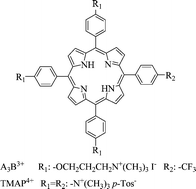The mechanistic aspects of Escherichia coli photodynamic inactivation (PDI) have been investigated in bacteria treated with 5,10,15-tris[4-(3-N,N,N-trimethylammoniumpropoxy)phenyl]-20-(4-trifluoromethylphenyl)porphyrin iodide (A3B3+) and visible light. The photosensitization activity of A3B3+ porphyrin was compared with that of 5,10,15,20-tetra(4-N,N,N-trimethylammonium phenyl)porphyrin p-tosylate (TMAP4+), which is an active tetracationic sensitizer to eradicate bacteria. The PDI damages on plasmid and genomic DNA were analyzed by electrophoresis. DNA photocleavage was observed after a long period of irradiation, when the bacterial cells are largely photoinactivated. Transmission electron microscopy (TEM) revealed structural changes with appearance of low density areas into the cells and irregularities in cell barriers, which could affect the normal cell membrane functionality. Also, damages on the cell-wall were not detected by scanning electron microscopy (SEM) and release of intracellular biopolymers was not found after PDI. These results indicate that the photodynamic activity of these cationic porphyrins produces DNA photodamage after a long period of irradiation. Therefore, an interference with membrane functions could be the main cause of E. coli photoinactivation upon short PDI treatments.

You have access to this article
 Please wait while we load your content...
Something went wrong. Try again?
Please wait while we load your content...
Something went wrong. Try again?


 Please wait while we load your content...
Please wait while we load your content...